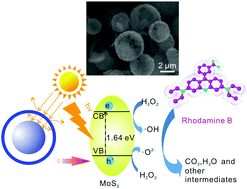当前位置:
X-MOL 学术
›
Inorg. Chem. Front.
›
论文详情
Our official English website, www.x-mol.net, welcomes your
feedback! (Note: you will need to create a separate account there.)
Facile synthesis of monodispersed yolk-shelled molybdenum disulfide microspheres with enhanced photocatalytic properties†
Inorganic Chemistry Frontiers ( IF 6.1 ) Pub Date : 2018-09-27 00:00:00 , DOI: 10.1039/c8qi00878g Yongxing Zhang 1, 2, 3, 4 , Yuanyuan Zhao 1, 2, 3, 4 , Jia Li 1, 2, 3, 4 , Li Li 1, 2, 3, 4 , Yi Liu 1, 2, 3, 4 , Dong Ma 1, 2, 3, 4 , Dechuan Li 1, 2, 3, 4 , Xuanhua Li 4, 5, 6, 7, 8
Inorganic Chemistry Frontiers ( IF 6.1 ) Pub Date : 2018-09-27 00:00:00 , DOI: 10.1039/c8qi00878g Yongxing Zhang 1, 2, 3, 4 , Yuanyuan Zhao 1, 2, 3, 4 , Jia Li 1, 2, 3, 4 , Li Li 1, 2, 3, 4 , Yi Liu 1, 2, 3, 4 , Dong Ma 1, 2, 3, 4 , Dechuan Li 1, 2, 3, 4 , Xuanhua Li 4, 5, 6, 7, 8
Affiliation

|
The controllable preparation and development of a practical photocatalytic material with yolk-shelled structure remains a great challenge. Herein, monodispersed yolk-shelled molybdenum disulfide microspheres have been synthesized via a facile and economical hydrothermal method with the assistance of a surfactant (polyethylene-polypropylene glycol (P123)). Ostwald ripening is the main formation mechanism for the yolk-shelled structure. The photocatalytic activity of the sample is evaluated by monitoring the photodegradation of rhodamine B (RhB) under white light illumination (500 W xenon lamp) with the assistance of hydrogen peroxide (H2O2). The results indicate that the yolk-shelled microspheres display excellent photocatalytic activity and recycling stability. The photocatalytic degradation rate of yolk-shelled MoS2 microspheres is 97.6% after only 30 min, which is much higher than those of MoS2 particles synthesized without P123, MoS2 solid microspheres and commercial MoS2 (Experimental section) (54.7%, 4.6% and 9.6% at 30 min, respectively). The reaction rate constant (k) of the yolk-shelled microspheres for the photodegradation of RhB is 1.19 × 10−1 min−1, which is 1.58, 92.97 and 107.21 times faster than those of MoS2 particles (k2 = 7.51 × 10−2), MoS2 solid microspheres (k3 = 1.28 × 10−3) and commercial MoS2 (k4 = 1.11 × 10−3), respectively. Such a highly desired yolk-shelled structure enables higher multiple light reflections and scattering between the outer spherical shell and the interior core compared with MoS2 particles, MoS2 solid microspheres and commercial MoS2 to provide a more efficient way of enhancing light-harvesting efficiency.
中文翻译:

轻松合成具有增强的光催化性能的单分散卵黄壳型二硫化钼微球†
具有卵黄壳结构的实用光催化材料的可控制备和开发仍然是一个巨大的挑战。在此,借助于表面活性剂(聚乙烯-聚丙二醇(P123)),通过简便且经济的水热法合成了单分散的卵黄壳型二硫化钼微球。奥斯特瓦尔德熟化是蛋壳结构的主要形成机理。通过在过氧化氢(H 2 O 2)辅助下在白光照明(500 W氙气灯)下监测若丹明B(RhB)的光降解来评估样品的光催化活性。)。结果表明,蛋黄壳微球显示出优异的光催化活性和循环稳定性。仅30分钟后,蛋黄壳型MoS 2微球的光催化降解率为97.6%,远高于不含P123,MoS 2固体微球和市售MoS 2的MoS 2颗粒的合成(实验部分)(54.7%,4.6) 30分钟时分别为%和9.6%)。蛋黄壳微球对RhB光降解的反应速率常数(k)为1.19×10 -1 min -1,比MoS 2颗粒(k 2)快1.58、92.97和107.21倍= 7.51×10 -2,MoS 2固体微球(k 3= 1.28×10 -3)和市售MoS 2(k 4= 1.11×10 -3)。与MoS 2颗粒,MoS 2固体微球和市售MoS 2相比,这种高度期望的蛋黄壳结构能够在球形外壳和内部核之间实现更高的多重光反射和散射,从而提供一种更有效的方式来提高捕光效率。
更新日期:2018-09-27
中文翻译:

轻松合成具有增强的光催化性能的单分散卵黄壳型二硫化钼微球†
具有卵黄壳结构的实用光催化材料的可控制备和开发仍然是一个巨大的挑战。在此,借助于表面活性剂(聚乙烯-聚丙二醇(P123)),通过简便且经济的水热法合成了单分散的卵黄壳型二硫化钼微球。奥斯特瓦尔德熟化是蛋壳结构的主要形成机理。通过在过氧化氢(H 2 O 2)辅助下在白光照明(500 W氙气灯)下监测若丹明B(RhB)的光降解来评估样品的光催化活性。)。结果表明,蛋黄壳微球显示出优异的光催化活性和循环稳定性。仅30分钟后,蛋黄壳型MoS 2微球的光催化降解率为97.6%,远高于不含P123,MoS 2固体微球和市售MoS 2的MoS 2颗粒的合成(实验部分)(54.7%,4.6) 30分钟时分别为%和9.6%)。蛋黄壳微球对RhB光降解的反应速率常数(k)为1.19×10 -1 min -1,比MoS 2颗粒(k 2)快1.58、92.97和107.21倍= 7.51×10 -2,MoS 2固体微球(k 3= 1.28×10 -3)和市售MoS 2(k 4= 1.11×10 -3)。与MoS 2颗粒,MoS 2固体微球和市售MoS 2相比,这种高度期望的蛋黄壳结构能够在球形外壳和内部核之间实现更高的多重光反射和散射,从而提供一种更有效的方式来提高捕光效率。











































 京公网安备 11010802027423号
京公网安备 11010802027423号